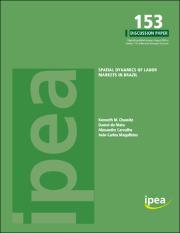Please use this identifier to cite or link to this item:
https://repositorio.ipea.gov.br/handle/11058/4932Full metadata record
| DC Field | Value | Language |
|---|---|---|
| dc.contributor.author | Chomitz, Kenneth M. | - |
| dc.contributor.author | Mata, Daniel da | - |
| dc.contributor.author | Carvalho, Alexandre Xavier Ywata de | - |
| dc.contributor.author | Magalhães, João Carlos Ramos | - |
| dc.contributor.other | Andersson, Jonny | - |
| dc.contributor.other | Buys, Piet | - |
| dc.contributor.other | Guia, George da | - |
| dc.contributor.other | Netto, Waldir | - |
| dc.contributor.other | Tebaldi, Edinaldo | - |
| dc.contributor.other | Deichmann, Uwe | - |
| dc.contributor.other | Lall, Somik | - |
| dc.contributor.other | Morais, Maria da Piedade | - |
| dc.contributor.other | Piancastelli, Marcelo | - |
| dc.contributor.other | Henderson, Vernon | - |
| dc.coverage.spatial | Brasil | pt_BR |
| dc.date.accessioned | 2015-10-28T14:33:35Z | - |
| dc.date.available | 2015-10-28T14:33:35Z | - |
| dc.date.issued | 2015-01 | - |
| dc.identifier.uri | http://repositorio.ipea.gov.br/handle/11058/4932 | - |
| dc.description.abstract | O mercado de trabalho brasileiro apresentou uma dinâmica espacial diversa durante a década de 1990. Em 2000, aproximadamente um quinto dos trabalhadores vivia em municípios aparentemente estagnados em termos econômicos, em que os salários reais caíam, mas em que o emprego crescia acima da taxa de crescimento populacional do Brasil. Por outro lado, mais de um terço dos trabalhadores vivia em municípios dinâmicos, com crescimento dos salários reais e crescimento do emprego acima do crescimento populacional brasileiro: essas áreas absorveram mais da metade do crescimento líquido do emprego durante o período. A fim de elucidar essa dinâmica, o presente artigo estimou um modelo espacial de demanda e oferta por trabalho no qual descreve as mudanças no nível de salários e empregos dos municípios. Foi utilizado o método GMM espacial desenvolvido por Conley (1999), que permite o uso de variáveis instrumentais na presença de autocorrelação espacial. Os principais resultados incluem: a influência muito forte do nível educacional inicial da força de trabalho na taxa de crescimento subseqüente dos salários (mesmo após controlar por diversas variáveis, tais como distância e clima); presença de efeitos de transbordamento positivos do crescimento do município sobre os níveis de salário e emprego de seus vizinhos; queda no emprego em atividades rurais; elasticidade na resposta dos salários a um aumento na oferta de trabalho; e presença de efeitos multiplicadores das transferências governamentais. | pt_BR |
| dc.language.iso | en-US | pt_BR |
| dc.publisher | Instituto de Pesquisa Econômica Aplicada (Ipea) | pt_BR |
| dc.title | Spatial dynamics of labor markets in Brazil | pt_BR |
| dc.title.alternative | Discussion Paper 153 : Spatial dynamics of labor markets in Brazil | pt_BR |
| dc.title.alternative | Dinâmica espacial dos mercados de trabalho no Brasil | pt_BR |
| dc.type | Discussion Paper | pt_BR |
| dc.rights.holder | Instituto de Pesquisa Econômica Aplicada (Ipea) | pt_BR |
| dc.source.urlsource | http://www.ipea.gov.br | pt_BR |
| dc.location.country | BR | pt_BR |
| dc.description.physical | 37 p. : il. | pt_BR |
| dc.rights.license | Reproduction of this text and the data it contains is allowed as long as the source is cited. Reproductions for commercial purposes are prohibited. | pt_BR |
| dc.subject.keyword | Mercado de Trabalho | pt_BR |
| dc.subject.keyword | Dinâmica espacial do mercado de trabalho | pt_BR |
| dc.subject.keyword | Demanda e oferta por trabalho | pt_BR |
| dc.subject.keyword | Dinâmica do emprego | pt_BR |
| dc.relation.references | http://repositorio.ipea.gov.br/handle/11058/1601 | pt_BR |
| ipea.description.objective | Estimar um modelo espacial de demanda e oferta por trabalho que descreva as mudanças no nível de salários e empregos dos municípios brasileiros. | pt_BR |
| ipea.description.additionalinformation | Série monográfica: Discussion Paper ; 153 | pt_BR |
| ipea.description.additionalinformation | Possui referências bibliográficas | pt_BR |
| ipea.description.additionalinformation | Série: Originally published by Ipea in August 2005 as number 1110 of the series Texto para Discussão | pt_BR |
| ipea.access.type | Acesso Aberto | pt_BR |
| ipea.rights.type | Licença Comum | pt_BR |
| ipea.englishdescription.abstract | There was substantial spatial variation in labor market outcomes in Brazil over the 1990’s. In 2000, about one fifth of workers lived in apparently economically stagnant municipios where real wages declined but employment increased faster than the national population growth rate. More than one third lived in apparently dynamic municipios experiencing both real wage growth and faster-than-average employment growth; these areas absorbed more than half of net employment growth over the period. To elucidate this spatial variation, we estimated spatial labor supply and demand equations describing wage and employment changes of Brazilian municípios. We used Conley’s spatial GMM technique to allow for instrumental variable estimation in the presence of spatially autocorrelated errors. Chief findings include: a very strong influence of initial workforce educational levels on subsequent wage growth (controlling for possibly confounding variables such as remoteness and climate); evidence of positive spillover effects of own-municipio growth onto neighbors’ wage and employment levels; an exodus from farming areas; relatively elastic response of wages to an increase in labor supply; and evidence of a local multiplier effect from government transfers. | pt_BR |
| ipea.researchfields | N/A | pt_BR |
| ipea.classification | Emprego. Trabalho | pt_BR |
| Appears in Collections: | Emprego. Trabalho: Livros | |
Files in This Item:
| File | Description | Size | Format | |
|---|---|---|---|---|
| DiscussionPaper_153.pdf | 1.99 MB | Adobe PDF |  View/Open |
Items in DSpace are protected by copyright, with all rights reserved, unless otherwise indicated.

